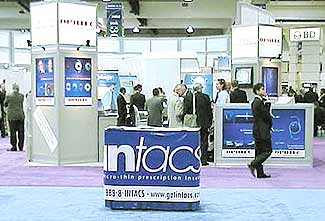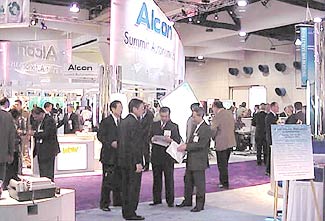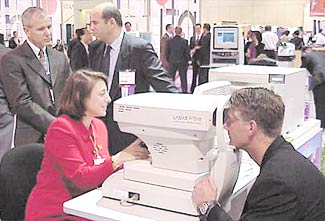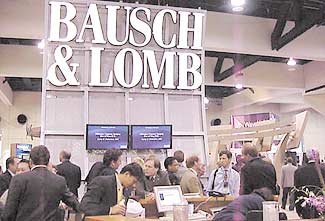ASCRS meeting captures surgical industry in transition
Blockbuster pharm products boost surgical companies, mega-acquisitions progress, a neighbor is downsized. The ASCRS exhibit hall was a business-cycle tableau.
|
|
SAN DIEGO — There is no prevailing wind today in the anterior segment ophthalmic market: cataract is flat to declining, refractive surgery's boom has hit its first bump, glaucoma is growing but getting harshly competitive. It is no surprise that the pressure on companies to grow or die is at its peak, but it is startling to see each stage of business — birth, growth, “marriage,” maturity, and decline — on display in one place.
That place was here in the exhibit hall of the annual meeting of the American Society of Cataract and Refractive Surgery. Last year, Alcon and Summit Autonomous were in the same neighborhood. Here they combined two large booth spaces into the single largest exhibit. CIBA Vision and Novartis Ophthalmics, on the other hand, were split across an exhibit floor aisle this year, just as they soon will be physically divided into two separate headquarters locations in an Atlanta office park.
The most dramatic sign of change, however, was in booth number 1251. Instead of well-lit counters stocked with products and literature, a single table stood in the 400-square-foot space. The table was not quite as wide as the logo for Intacs, the only product of now-bankrupt KeraVision, on the banner being used as skirting.
The view was considerably brighter from the long row down the center of the hall where ophthalmology's “Big 5” firms resided.
Alcon Summit Autonomous
 It was as close to a billion-dollar deal as
ophthalmology has ever seen. So how far along is Alcon's integration of Summit
Autonomous? Bill Barton, Alcon's vice president and general manager for U.S.
surgical, gave Ocular Surgery News an update.
It was as close to a billion-dollar deal as
ophthalmology has ever seen. So how far along is Alcon's integration of Summit
Autonomous? Bill Barton, Alcon's vice president and general manager for U.S.
surgical, gave Ocular Surgery News an update.
“In terms of employee status and benefits and all the H.R. kinds of things, we're there. In terms of branding and educating everyone on all the Summit Autonomous products, maybe we're halfway there.”
Mr. Barton said he is pleased with the progress so far, and with the reception the refractive surgery marketplace is giving Alcon.
“The response I get most frequently is ‘We're glad to see Alcon getting into refractive. It's validating to see the number one surgical company in ophthalmology getting into the field.' Our customers expect great things, and we're working hard trying to meet those expectations.”
Alcon Summit Autonomous showed their new model excimer, the LADARVision 4000, for the first time in San Diego. The essential elements of the laser's high-sample-speed tracking system remain unchanged, however.
|
|
“It is an upgrade with improvements in ergonomics and other aids to the surgeon,” Mr. Barton explained. The manufacturing lines are currently being retooled to produce the new model, and field upgrades of installed LADARVision lasers will be performed.
Wavefront is still the key word when talking about the future of refractive surgery, and Alcon announced an agreement with Zeiss Humphrey to develop a Hartmann-Shack aberrometer for use with the LADARVision excimer. The target date for delivery of the LADARWave aberrometer is fourth quarter 2001, according to Mr. Barton.
On the cataract/IOL side, the one-piece AcrySof “introduces a whole new lens technology,” Mr. Barton said.
The haptic design allows the lens to conform to the capsular bag rather than making the capsule wrap around the lens, Mr. Barton said. Surgeons should see fewer striae and resulting Maddox rod effect.
“And for the first time, a full 6-mm optic without any obstructions to the optical zone will go through a 3-mm or less incision. It's the fastest growing new product that we've introduced.”
Products on line for future development include a toric AcrySof, now in U.S. clinical trials.
“We also have a multifocal IOL that seems to avoid all the unwanted images that we've seen in the past,” Mr. Barton continued. “We do that by marrying refractive and diffractive optics. We have phakic IOLs being investigated in Europe, and we have begun work on an intracorneal implant.”
Nominally a cataract and refractive surgery symposium, the ASCRS scientific program has included glaucoma for a number of years. This year, ASCRS was the first major ophthalmic meeting where Alcon, Allergan and Pharmacia have displayed their approved prostaglandin-type glaucoma medications Travatan, Lumigan, and Xalatan respectively. The two newly approved drugs in the class appear well-positioned for winning the confidence of ophthalmologists (see “Lumigan, Travatan, Alphagan P okayed,” April 15 issue, page 1). The strategy being taken by the market leader is simple.
Pharmacia
“Xalatan has a proven record and the best safety profile,” said Anders Härfstrand, MD, PhD, vice president of the global ophthalmology business for Pharmacia. “Xalatan is indeed the gold standard today, with more than 50 million prescriptions written. Sales continue to grow by about 25% over last year.”
The prostaglandin-type drug segment is about to become a little more crowded in Europe, where the latanoprost-timolol combination Xalcom is being submitted for mutual European Union recognition based on its approval in Sweden. Pharmacia is still waiting for U.S. Food and Drug Administration (FDA) approval.
Overall, it is still a good time to be doing business in eye care, according to this executive.
“We see the total ophthalmology business still growing by up to 15% per year,” Dr. Härfstrand said,” with most of that growth in refractive surgery. “The only area that is not growing is cataract.”
Although the cataract market as a whole is not growing, Dr. Härfstrand emphasized that it is an essential market in which new products like Healon 5 and the Cee-On Edge silicone IOL are preserving Pharmacia's share.
“We have been in the cataract surgery field for 20 years,” he said, “and quality of life after cataract surgery has improved greatly in those 20 years. Patients have come to expect instant recovery. To have a clear, healthy cornea after surgery you need modern surgical procedures and endothelial protection, which you get from Healon 5.”
Surgeons also have greater expectations for IOL performance over the longer term, especially concerning posterior capsule opacification (PCO).
“You need to create a non-glare IOL optic,” Dr. Härfstrand said, “and as far as possible a PCO-free lens.” This was the company's goal in developing the Cee-On Edge design, he added. “We think that for the next generation of patients, this will be an improvement.”
Allergan
The following announcements were made in the week preceding the ASCRS meeting.
April 18: (press release) Allergan Inc. exercises option to buy back its December 1997 R&D spin-off ASTI for $71 million; associated $40 million charge to be taken in second quarter.
April 24: (press release, first quarter report) Allergan beats Wall Street's expectations for diluted earnings per share by $0.02, more growth to come from approvals of Lumigan (initial U.S. OK), Botox (additional indication in Canada), Sensar (initial Japanese approval) and contact lens products (wider approvals in Europe and Japan). Global pharm sales up 7.5% (to $188 million in first quarter), “slower” surgical growth of 5.7% (to $56.7 million).
April 24: (Nihon Keizai Shimbun) Allergan to move from licensing to direct sales in Japan by 2005.
April 25: (press release) Allergan board makes David E.I. Pyott chairman as well as president and CEO.
In an April 30 interview, Mr. Pyott told Ocular Surgery News the rest of the news from Allergan.
“The most important news of the quarter was the expansion of our distribution rights to worldwide for the Amadeus microkeratome,” Mr. Pyott said. “We are talking with Visx about expanding our relationship with them.”
Only North and South American rights had previously been licensed from Swiss original equipment manufacturer SIS.
“You don't have to own everything to have a good business,” Mr. Pyott said of the licensing agreement. “It goes back to core competencies, like with our phaco machines being manufactured by Zeiss/Humphrey. We are now No. 1 in phaco market share in Europe thanks to the tremendous success of the Sovereign.”
Allergan's Sensar acrylic IOL has also taken hold in the European IOL market, according to Mr. Pyott. The lens is relatively new to the United States, but Allergan has already announced a design change that is in early clinical trials.
Named OptiEdge, the lens is designed with a squared-off posterior optic edge that inhibits posterior capsule opacification, and the 5° posterior vault of the haptics maintains posterior capsule contact. The superior edge surface of the optic is inclined inward, however, and the anterior edge is rounded off to defeat the reflections that have been noted with the square edge of the AcrySof lens.
The Sensar with OptiEdge is still in trials, but just weeks before the ASCRS meeting, Allergan received FDA approval for two new pharmaceuticals.
Lumigan (bimatoprost ophthalmic solution) is Allergan's newest glaucoma drug. Lumigan is a synthetic prostamide analog. Prostamides are members of the lipid family, as are prostaglandins. Lumigan and prostamides do not bind at prostaglandin receptors and are therefore thought to act at a new member of lipid family receptors.
“If you think about it,” Mr. Pyott said, “it's similar
to the situation with adrenergic receptors where you have
+,
2, B1 and B2 receptors. Like
beta-blockers and alpha-agonists, lipid family members share certain biological
traits, but also show significant differences and have different
pathways.” Lumigan is not a prostaglandin prodrug, he added, as he has
heard it mistakenly described.
Due to its favorable efficacy and safety profile, reactions to Lumigan are very positive. The availability of Lumigan in two sizes (2.5 and 5 mL) “has been well received by patients and HMOs,” Mr. Pyott said. The fact that Lumigan does not have to be refrigerated (whereas Xalatan does) also seems to make the drug more appealing.
The other recent approval was for Alphagan P, a new formulation of the popular glaucoma drug preserved with Purite, the same preservative used in Allergan's Refresh Tears.
“Alphagan P won't be launched until the end of summer because of everything going on with Lumigan,” Mr. Pyott said. “Alphagan's place will become stronger over time (as an adjunct therapy).” In anticipation of all this growth, Allergan plans to continue adding to its sales force.
“We say we're going to be the No. 1 company in ophthalmology by 2003, Mr. Pyott said. “You can see we're making the necessary investment to make that happen.”
Bausch & Lomb
|
|
Bausch & Lomb has had some hard times on Wall Street, but a top manager wants customers to know that they can still rely on the company.
“It's a matter of perspective,” said Mark M. Sieczkarek, president for Europe, Middle East and Africa. “Like many other companies we have restructured to effectively address our current business while remaining very healthy financially. Our R&D spending is going up. We continue to acquire and invest in technology and we are committed to the future of vision care We are developing the Envision TD posterior segment implant and are excited at the possibilities there.
“An example of our commitment and new technology is Zyoptix — customized ablation with the new Technolas hardware and software that was released just after (the 2000 meeting of the European Society of Cataract and Refractive Surgeons). We are moving ahead with a successful launch and having great results in Europe and Asia, where demand is outstripping supply at this time.”
Zyoptix uses topography and aberrometry measurements taken by the latest generation Orbscan instrument to plan a customized corneal ablation. According to Mr. Sieczkarek, the theoretical improvements in outcome are being seen in the early clinical results.
“Our Planoscan data submitted for FDA approval was the best in the industry, and Zyoptix is outdoing even that data,” he said.
A broad line of IOLs is available from the company in Europe, Mr. Sieczkarek pointed out, as last year's acquisition of Chauvin added acrylic lenses to the existing PMMA, silicone, and hydrogel models.
“The HydroView is is one of the top two lenses in Europe,” he added, “and we are planning to launch that lens in the U.S. by the end of the year after manufacturing scale-up.”
Novartis Ophthalmics
Although its restructuring has been purely internal, the challenge to the former CIBA Vision of establishing two new corporate identities has been significant. But to the North American president of Novartis Ophthalmics, there have been good reasons for making the effort.
“As [Novartis CEO] Dr. Vasella says, ‘Our mission is pharmaceuticals,'” Dan Myers told Ocular Surgery News. “That is what we think we do best.”
The combination of ophthalmic pharmaceutical and surgical businesses in the former CIBA Vision Ophthalmics seemed logical, but it was not functional, Mr. Myers explained.
“The development cycle of a drug and the development cycle of a device are so different that you really don't get any synergy. Plus, we wanted to get ophthalmology plugged into the global pharmaceutical R&D of Novartis.” Thus the company re-organized to put the ophthalmic drug business of Novartis on a par with its oncology, transplantation and “mature products” lines. The realignment seems promising, given the successful migration of photodynamic therapy (PDT) from oncology to ophthalmic research.
“Visudyne therapy for a certain type of wet age-related macular degeneration has given us a taste of what a blockbuster drug can do,” Mr. Myers said. “Visudyne is the most successful drug ever in ophthalmology based on total U.S. sales in the first year.” Those sales totaled just over $100 million in the 12 months following the FDA approval of Visudyne for PDT. Additional indications have been submitted to the FDA, and Novartis Ophthalmics is acquiring the international approvals necessary to make Visudyne a truly global brand.
Other brands round out the company's eye care drug portfolio. Sales of the company's former flagship product Voltaren Ophthalmic (diclofenac) have recovered following the 1999 warning from ASCRS about potential complications.
“We're pleased with the rebound in sales of Voltaren Ophthalmic. We expect this to continue with the recent announcement by ASCRS that they have received no adverse events reports of diclofenac since the withdrawal of the generic product,” Mr. Myers said.
Zaditor (ketotifen) has begun to capture a greater share of the allergy market. The GenTeal family of dry eye products, particularly the new gel formulation along with other OTC products, is contributing to the bottom line.
Distribution of the company's new glaucoma drug, Rescula (unoprostone), fell behind schedule due to a production bottleneck, but is now on line.
“Rescula is not a first-line therapy,” Mr. Myers acknowledged. “But it addresses areas of interest other than IOP, like ocular blood flow, and that will give it an advantage when patients need a second or third drug. If we can get doctors to start thinking about Rescula when their first-line drug isn't enough, or the side effects of some of their alternative therapies are a problem, I'd be very happy with that piece of the market.”
New drugs in development address the whole spectrum of eye disorders.
“Visudyne targets AMD near the end of the pathological pathway where the damage occurs,” Mr. Myers said. “We think the most recent work on AMD will allow us to move the treatment further up that pathway.”
One of several investigational products, PKC 412, is now in phase 2 trials for the treatment of diabetic retinal edema, Mr. Myers said, and the gene therapy pipeline at Novartis includes projects addressing AMD, glaucoma, myopia, and other ophthalmic conditions.
Mr. Myers sees a continuing long-term expansion of the ophthalmic pharmaceutical market.
“The ophthalmic drug market was $5.4 billion in 2000,” he said, “which represented 12.6% annual growth. We expect annual growth of 8% or more to 2009, at which time we estimate a total market of $15.6 billion if treatments for dry eye, presbyopia and myopia get established.”
He is optimistic about the prospects for Novartis Ophthalmics over the short term, too.
“About 90% of our ophthalmic portfolio revenue is from products that have been launched in the last 3 years,” Mr. Myers said. “We're not anywhere near the end of their life cycle.”
CIBA Vision
The non-pharmaceutical business unit that remained after the unbundling of Novartis Ophthalmics in January continues operation today as CIBA Vision. Contact lens products, lens solutions and ophthalmic surgical products constitute the business of CIBA Vision.
An evening cruise on The Spirit of San Diego marked the launch of CIBA Vision Surgical's Newest IOL: the CV232, a more tightly pre-folded MemoryLens that can be implanted through a smaller incision. Having overcome a manufacturing problem last year that led to postop inflammation in a small percentage of lenses, CIBA Vision is pointing to the excellent clinical record of the MemoryLens as published in the peer-reviewed literature. The product's performance record is not always represented fairly, the company argues.
“We have heard some outrageous claims about our PCO rate, for example,” said Patrick H. King, regional vice president of the surgical business unit of CIBA Vision. The U.S. clinical trial data compiled by James Memmen, MD, and other investigators conforms to what was presented here at the 2001 ASCRS by Nadia Jiraskova, MD, and coworkers (“Three-year results of a multicentric study with Memory Lens”). Capsulotomy rates in a series of 500 patients were 3.5% at 1 year, 4.1% at 2 years and 6.9% at 3 years after surgery.
“Additionally, there have been some misunderstandings about the porosity in hydrophilic lenses, the MemoryLens in particular,” Mr. King added. Terence O'Brien, MD, investigated this question and reported here on the “Determination of porosity size of hydrophilic acrylic material MemoryLens.”
In this experiment, a 100 µm-thick sample of MemoryLens material was placed in a two-cell diffusion chamber. None of the proteins examined and no vitamin B12 or dextrin were able to pass through the material, which was determined to have a porosity size of 13 Å.
“(N)o protein absorption and diffusion through this hydrophilic acrylic (MemoryLens) material is likely,” the investigators wrote in the presentation abstract.
“So if protein can't get into the lens,” Mr. King said, “how is bacteria supposed to get into the lens? It's a non-issue.”
Even before Novartis Ophthalmics was spun off of CIBA Vision, plans always included phakic IOLs. That development work continues.
“We made an equity investment in Medennium, which has the Phakic Refractive Lens (PRL),” Mr. King said. “It already has the CE mark and is being implanted in Europe, and it is entering phase 3 trials in the U.S.
“We know it is going to take a while to get this new technology into the doctors' hands,” Mr. King added, “but we definitely see it as part of the refractive market of the future.” CIBA Vision is already planning to hire more staff for its cataract and refractive surgical businesses.
For Your Information:
- Alcon Surgical can be reached at 6201 South Freeway, Fort Worth, TX 76134; (800) 826-5266; fax: (817) 241-0677.
- Pharmacia can be reached at 100 Route 206 North, Peapack, NJ 07977; (888) 768-5501.
- Allergan can be reached at 2525 Dupont Drive, Irvine, CA 92612; (800) 433-8871; fax: (714) 246-5913; Web site: www.allergan.com.
- Bausch & Lomb Pharmaceuticals can be reached at 8500 Hidden River Pkwy., Tampa, FL 33637; (800) 323-0000; fax: (813) 975-7762.
- Novartis Ophthalmics can be reached at 11460 Johns Creek Pkwy, Duluth, GA 30097; (800) 533-1676; fax: (678) 415-2378.
- CIBA Vision-Surgical can be reached at 11460 Johns Creek Pkwy, Duluth, GA 30097; (678) 415-3711; fax: (678) 415-2320.




